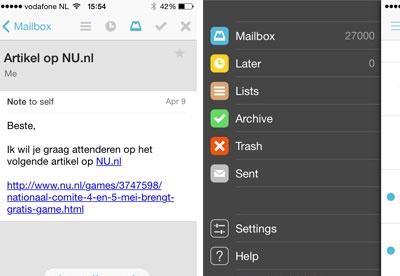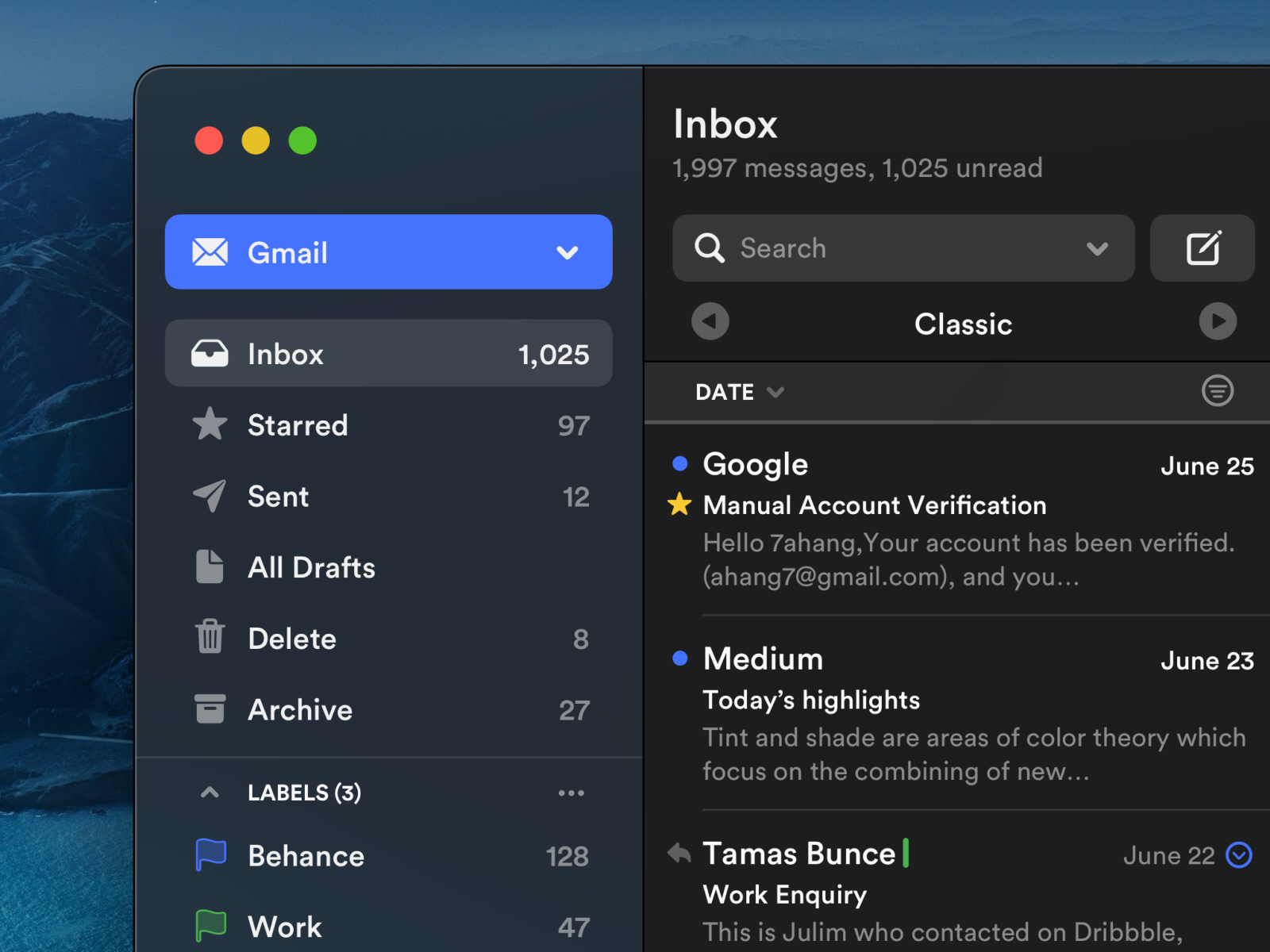Spark helps you take your inbox under control. Instantly see what’s important and quickly clean up the rest. Spark for Teams allows you to create, discuss, and share email with your colleagues. Feb 18, 2020 Even if you don't work on a computer during the day, you probably sit down in front of it to check your inbox at the end of the day. If the Mail app that comes with your Mac doesn't provide the features you need, you're in luck. There are dozens of great email apps in the Mac App Store. I've tested many of them and these are my favorites.
Apple and Microsoft go toe-to-toe on several fronts like Word processing apps. However, Apple aims to offer a solid email experience with the Mail app on iOS, iPadOS, and macOS, but it still leaves a lot to be desired. That's why you can't help but look at a viable alternative from Microsoft's camp - Outlook for Mac.
Mac Os Catalina
Recently, Microsoft revealed the brand-new look for Outlook for Mac, which is available through the Fast Insider group. That coupled with a bunch of other software integration in the Outlook for Mac app makes it a viable rival to the Apple Mail app.
In this post, we shall compare Outlook Mail for Mac to the default Apple Mail app. The comparison will be based on UI, Email Organization, Compose Mail, features, and apps integration. Let’s get started.
Cross-Platform Availability
Mailbox Rebuild Mac Os X
I know cross-platform availability doesn’t matter much in an Email app. But I’m mentioning here so that you can expect a seamless experience on every platform. Apple Mail is only available on iOS, macOS, and iPadOS.
On the other hand, Microsoft Outlook is accessible on Android, iOS, Windows, macOS and Web.
Download Microsoft Outlook for MacMac Os Update
Also on Guiding Tech
Top 5 Apple Mail Alternatives for iPhone
Read MoreUser Interface and Customization
Microsoft's plans to redesign the interface of Outlook for Mac is much needed to keep it in line with other platforms. There's a catch when it comes to trying out the new Outlook for Mac. You'll have to install it along with other Office apps through an ISO installer.
When you open Outlook for Mac, you'll notice the Compose (New Message) button and Search bar at the top. On the left sidebar, you'll find your email accounts and other folders. It is impressive how Microsoft uses a column layout style and adds the calendar integration to the extreme right. You won’t have a hard time navigating the new look.
You can change the default fonts for new mail, reply mail from the Outlook settings.
Apple Mail looks quite vanilla compared to the Outlook. The default interface shows the Email as well as folders on the left sidebar, messages list in the center, and mail view on the right. Interestingly, Apple Mail offers several customization options.
Go to Mail > Preferences > Fonts & Colors. From there, you can change the message list font, message font, and even fixed-width font. Apple Mail also allows you to change the list view preview from the default 2 lines to 3 lines or more.
On My Mac Mailbox
Compose Mail
Apple Mail offers a bunch of editing options when you compose a mail. While writing a mail, you can change the font type, size, color, play with bold, italic options, and even add a bullet or number list.
I like how the Mail app lets you add the picture or scanned documents directly from the connected iPhone.
Outlook’s compose menu toolbar is richer than Apple Mail. It lets you highlight the words. You can even add tables and signature. Guess what? Outlook for Mac also supports templates. Yes, you can create ready-to-use templates with images and text. You can save them for later use. While composing an email, just tap on the three-dot menu above and select view templates and add a relevant one in the mail.
Such templates can be when you are composing emails related to specific subjects like marketing surveys, inquiries, and so on. Just create a master template with necessary text for each type or topic of emails you use often.
Also on Guiding Tech
Top 7 Useful macOS Apps to Optimize Your Mac
Read MoreAdditional Features
If you like flagging emails, the Apple Mail offers a couple of options for neater organization. For instance, you can assign an orange flag for Bank mails and green flag to all finance mails. Most mail apps only support the normal flag (Red color) option.
From the flagged mail section, you can quickly jump to the exact mail that you are looking for. Apple Mail also supports Rules. You can select Mail > Preferences > Rules and create personalized email rules for you. I have created a rule to archive all the emails that come with Coronavirus in the subject.
We can only hope that Apple integrates services such as Reminders, Calendar, and Notes in the Mail app. It would be easy to set reminders for an email or create an event for the Mail app meeting.
Outlook for Mac app also supports to Rules options. I would highly recommend you to set some of the effective rules to organize emails like a pro. The app comes with Calendar, Sticky Notes, and Microsoft To-Do integration.
It works like a charm. If you are using Outlook as your mail provider and if you flag an email in it, the mail automatically gets saved into the Flagged mail section in the Microsoft To-Do app.

Email Export and Third-Party Integration
Apple allows you to export any mail as a PDF file menu. Open any mail and go to File > Export as PDF, and it will create a PDF file from the selected mail. Unfortunately, the app doesn’t offer any third-party app integration.
Microsoft offers a dedicated third-party app store. You can tap on the three-dot menu and go to Get add-ins from a dedicated store in Outlook.
For example, I use OneNote and Trello extensions in Outlook to directly send the selected mail to the OneNote or Trello.
Also on Guiding Tech

#macos
Click here to see our macos articles pageUse Mail Like a Pro on Mac
The comparison above gives you a clear view of the Apple Mail and Outlook’s strength and weaknesses. Apple Mail wins with the simple UI, mail organization, and iPhone integration. However, several folks complain that it is sluggish and buggy. Also, it doesn't translate to a pleasant performance on iOS either. Outlook for Mac brings a breath of fresh air with Microsoft apps integration, richer compose menu, and third-party add-ins. Hopefully, the Outlook for iOS also gets a facelift soon. As of now, I’m sticking with Microsoft’s offering. What about you? Sound off in the comments section below.
Next up:Recently got a new Mac? Read the post below find the best Mac apps to stay organized.
The above article may contain affiliate links which help support Guiding Tech. However, it does not affect our editorial integrity. The content remains unbiased and authentic.Read Next7 Best Mac Apps to Stay OrganizedAlso See#macos #email
Did You Know
Email existed even before the world wide web.
More in Mac
Top 4 Ways to Fix Mac Desktop Icons Missing or Not Showing
Question: I have followed all the instructions on how to archive and save Mac Mail folders/emails and have saved one folder to my USB to test it out. When I plug the USB drive into the PC and run the software, it says it can’t find any files ending in .mbox or .mbx even though I can see folders ending with that suffix. Can you tell me what the problem is? What if my Mac Mail application does not have an option to Archive Mailbox? What should I do if my Mac OS X Mail application do not allow me to archive mailboxes?
Answer: Right click to the Mac Mail folder containing emails and use the “Export Mailbox…” option to save it into mailbox file. Do the same for other folders to archive them then use the main program guide.
Please don’t read below if the Export function is available and you may use it.
If the “Export Mailbox…” option is not available (older Mac Mail versions) you may need to find the folder containing the source mailboxes. Older Mac Mail versions store emails in *.emlx files and don’t allow to pack them into mailbox format. So you have nothing to do with email archiving option. You have to find the proper mailbox location and use the “Mailboxes” folder for the further conversion.
Note: Mac Mail may create several similar folders but the proper one is that which stores files with *.emlx extension. The message store location depending on Mac Mail application version and edition.
How to Find and Open the Folder Where Mac Mail Stores Emails
Do the following to find and open the folder where Mac OS X Mail v2, v3, v4 and above keeps your messages:
- Open a new Finder window
- Go to your home directory using the Home toolbar button or select Go | Home from the main menu
- Open the Library/Mail/Mailboxes directory
This will open up the correct directory where your Mac Mail stores emails. Usually this directory is called Mail and contains multiple sub-folders named the same way as your email accounts. POP accounts and IMAP accounts are named with prefix POP- and IMAP- respectively. Each account folder contains multiple sub-folders for your Mac Mail folders such as Inbox, Sent Items etc.
The folder called Mailboxes is the main storage for your emails. You should copy this folder including all subfolders and files inside to the Windows PC and use it as the Source Folder for the Mac Mail to Outlook Converter.
Take the following steps to open the folder where Mac OS X Mail v1 keeps your messages:
- Open Mac OS Finder application
- From the main menu select “Go” item
- Choose “Go to Folder…” menu item (You can also press Command-Shift-G).
- Type in “~/Library/Mail/V2” (for Mac OS X Mail 5-8)
or “~/Library/Mail/V3” (for Mac OS X Mail)
This indicating the location of the lication of the Mac Mail v1.0 mailbox. You have to use this folder as the source for the conversion.
